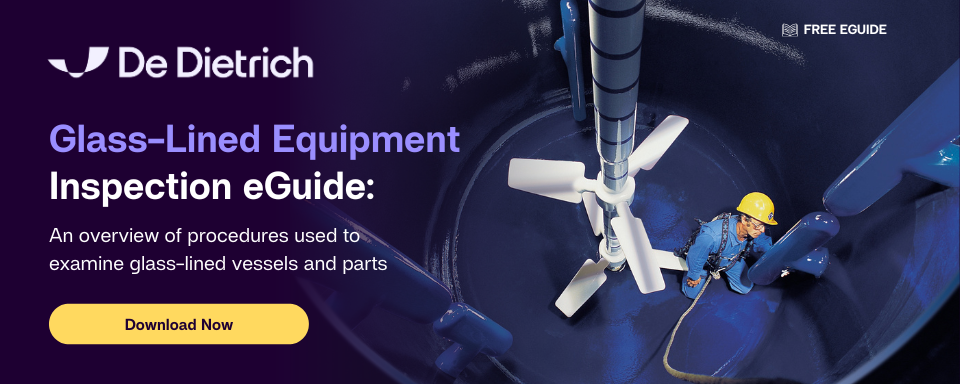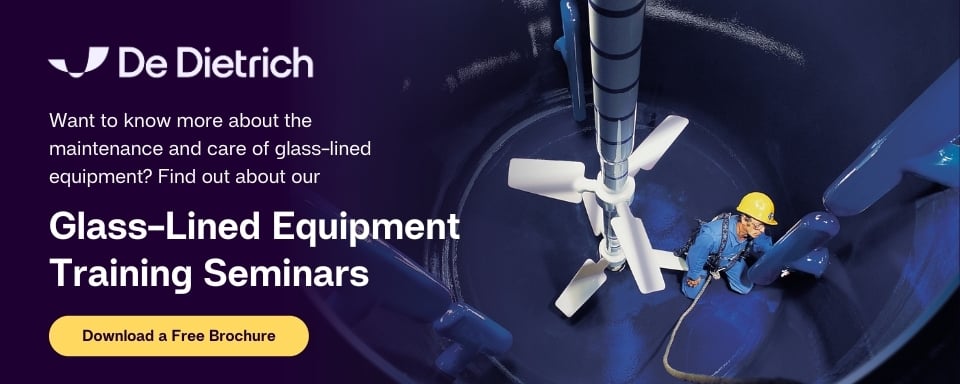Glass-Lined Equipment Guidelines, Optimization Tips, and Best Practices

We’ve been blogging for a few years now and have built up a substantial collection of posts that remain on our site for all the world to read (those places that have Internet access anyway). If you subscribe to our blog, you are alerted of new articles as they get published, but have you ever viewed posts by topic to browse through some of our older posts that might be of interest to you?
Some of our most popular articles were in fact written years ago. They seem to contain the right combination of useful, evergreen content that readers, like yourself, are searching for online. In this post, we want to shed some light on select articles related to the safety and handling guidelines and maintenance of glass-lined equipment.
Glass lining is a specialized material of construction. If you have never worked with glass-lined equipment before, there are some rudimentary things you need to know. These gems that have been hiding out in the shadows of our archives may contain the valuable information you’ve been looking for!
- Tips for Working Inside Glass-Lined Equipment is a great resource for maintenance personnel, especially ones who are aren’t accustomed to working inside vessels.
- As with any type of procedure, there are things you should do when it comes to glass-lined equipment and things you definitely should not do. This 2-part post helps define the do’s and don’ts - 12 Critical Do's and Don'ts for Glass-Lined Equipment (Part 1) and (Part 2).
- But what happens if you do one of those “don’ts”? Mistakes can happen, or other accidents out of your control that could potentially cause damage to your glass lining. “That Doesn’t Look Right”: How to Evaluate Glass Lining Damage (Part 1) and (Part 2) helps assess the type of damage you might be dealing with and the best method for fixing it. Repair Materials and Techniques for Restoring Glass-Lined Steel delves deeper into the specifics involved in plugs, patches, and other various repair methods.
- In Best Practices for Avoiding Damage in Glass-Lined Equipment (Part 1) and (Part 2) you’ll learn how to prevent damage from occurring in the first place. One of the topics discussed is highlighted further in the post How to Keep your Glass-Lined Equipment Safe from Thermal Shock.
- Taking proper care of your vessel is a common-sense way to keep your process running healthy. Basic “DIY” Preventative Maintenance for Glass-Lined Equipment (Part 1) and (Part 2) talk about establishing a preventative maintenance program for your equipment and the procedures you can put into practice to extend the life your vessel.
- There’s a lot to cover in a thorough equipment inspection. Not only do you have the inside and outside of the vessel to examine, but there are a series of components that make up a reactor system that need to be checked as well. Our posts entitled A Step-by-Step Guide to Glass-Lined Equipment Inspection and Inspection Checkpoints for Vessel Start-Up (Part 1) and (Part 2) are not only a great resource, but you can find a helpful (and free) downloadable Inspection Guide and Checklist at the end of the articles.
- Looking for some information to help you with a specific reactor component? Find out how to troubleshoot seal issues in Correcting Improper Performance of Mechanical Seals (Part 1) and (Part 2). If mixing piques your interest, read about some Agitation Best Practices for Improved Mixing. Jacket Care and Cleaning Options for Glass-Lined Reactors covers what you need to know about maintaining the outside of your reactor.
- Getting a new vessel or need to move an existing one to a different location? This post shares 9 Tips for Unloading, Rigging and Transferring Glass-Lined Vessels to instruct you how to handle your equipment properly to ensure no damage occurs during the move.
- If you are new to glass-lined equipment or are looking for a refresher course in how to handle and care for glass-lined equipment you might want to attend an upcoming training seminar. Read more about them in Why you Should want to Attend a Glass-Lined Training Seminar. Or send us your comments/questions below if there is a topic we haven’t covered.
I know we just covered a lot of ground in 700 words, but don’t get overwhelmed by all the content thrown your way! This post is meant to be a resource that provides links to some educational material covering various topics relevant to glass-lined equipment. If you have any specific needs that you would like to address, contact us with some information about your process needs/issues and we'd be happy to discuss them in more detail.

